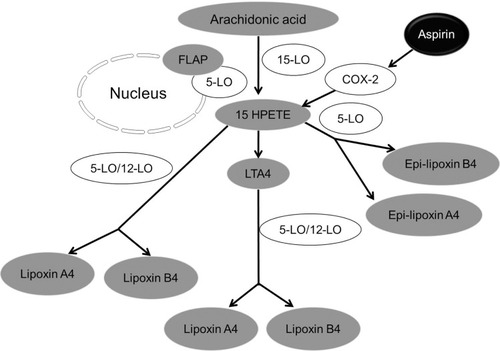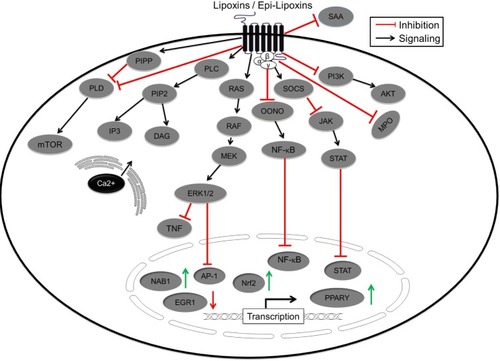Figures & data
Figure 1 Synthesis of lipoxin. Three major lipoxygenases (LO) such as 5-LO, 15-LO, and 12-LO are involved in lipoxin synthesis from arachidonic acid.
Notes: In the first route of lipoxin synthesis LTA4 is acted upon by 12-LO, and is converted to lipoxins. The second route of synthesis of lipoxins involves the action of a series of lipoxygenase (5-LO in neutrophils and 15-LO in erythrocytes) activities on arachidonic acid which then gets converted to 15-HEPTE. Lipoxins are formed from 15-HEPTE by the action of either 5-LO or 12-LO. The third route is the formation of epi-lipoxin A4 or aspirin-triggered lipoxin (ATL) and epi-lipoxin B4 whose generation is aspirin dependent. No fill represent enzymes whereas the gray filled represent the metabolites or end products.
Abbreviations: 15-HPETE, 15-hydroxyperoxyeicosatetraenoic acid; COX-2, cyclooxygenase-2; FLAP, 5-lipoxygenase-activating protein; LTA4, leukotriene A4.

Figure 2 effect of lipoxins on cytoplasmic signaling cascades and transcription factors.
Notes: Lipoxin binds to its G protein-coupled receptor ALX/Formyl peptidyl receptor triggering a wide array of cytoplasmic signaling cascades. Binding of lipoxin to its receptor ALX prevents binding of other pro-inflammatory ligands like SAA. Lipoxins could have alternative effects on PI3K and AKT pathway depending on the cell type. Lipoxins can control proliferation of immune cells and cancer cells by inhibiting growth promoting PI3K and AKT pathways. Lipoxins act to resolve inflammation by activating PI3K and AKT in macrophages to increase their life span. Lipoxin modulates levels of neutrophil for effective mounting and resolution of inflammation. They recruit neutrophils at the site of inflammation by increasing the cytosolic calcium levels and initiating pseudopodia movement, and at the same time control their proliferation by blocking MPO. Lipoxin controls synthesis and release of pro-inflammatory cytokines by increasing the mRNA level of suppressors of cytokine signaling and prevent transcription of inflammatory cytokines like IL-8 by inhibiting nuclear accumulation of NFκB and AP-1. Lipoxins are anti-angiogenic by blocking TNFα signaling. Lipoxins control the expression of inflammatory genes by decreasing levels of NFκB and AP-1 in the nucleus and increasing the levels of NAB1, Nrf2, and PPARγ. Green arrows indicate induction and red arrows indicate reduction in expression. Black lines indicate downstream biological events.
Abbreviations: AP-1, activator protein-1; DAG, diacyl-glycerol; EGR1, early growth response 1 gene; ERK, extracellular signal-regulated kinase; IL-8, interleukin 8; IP3, inositol triphosphate; JAK, Janus kinase; MEK, mitogen-activated protein kinase kinase; MPO, myeloperoxidase; mTOR, mammalian target of rapamycin; NAB1, NGFIA binding protein 1; NFκB, Nuclear factor κB; Nrf2, nuclear factor like 2; ONOO, peroxonitrite anion; PI3K, phosphatidylinositol-4,5-bisphosphate 3-kinase; PLD, phospholipase D; PPAR, peroxisome proliferator activated receptor; SAA, serum amyloid A; TNFα, tumor necrosis factor alpha; SOCS, suppressors of cytokine signaling; PIPP, polyisoprenyl phosphate.

